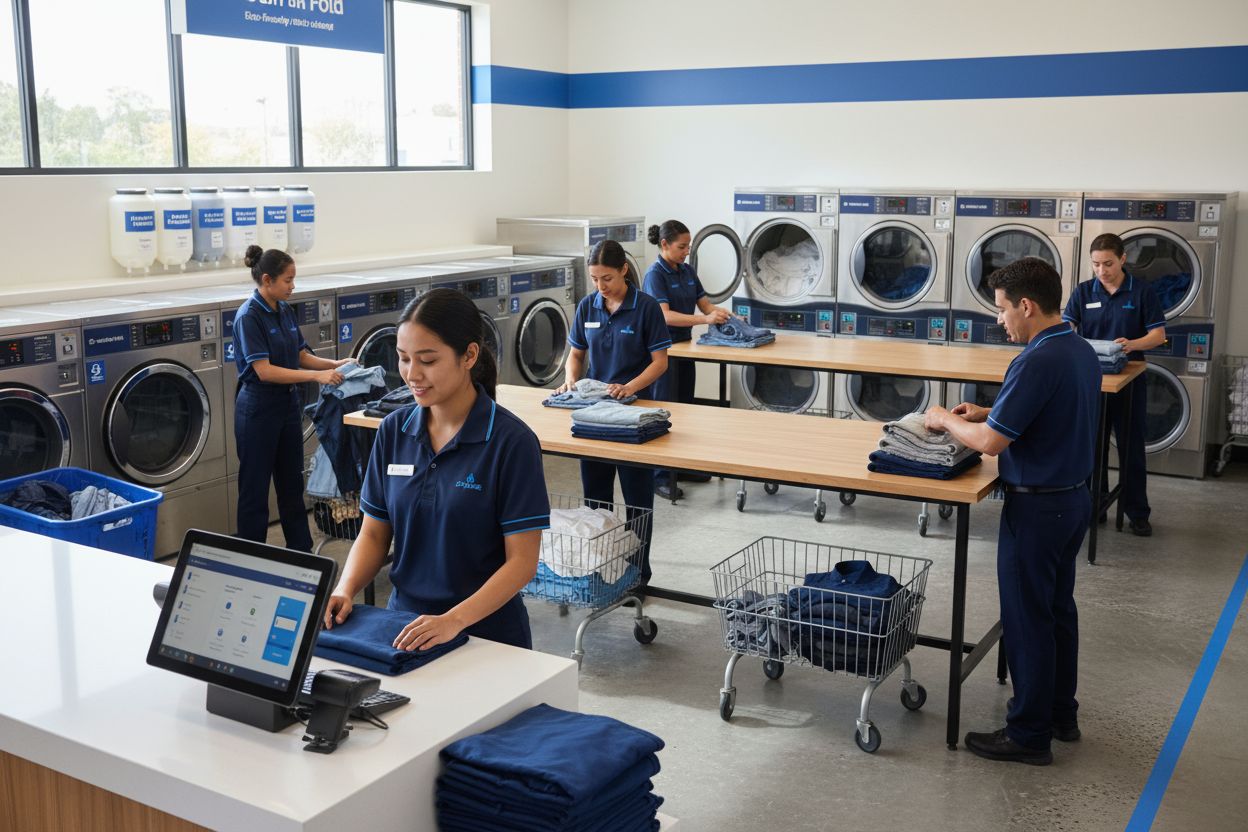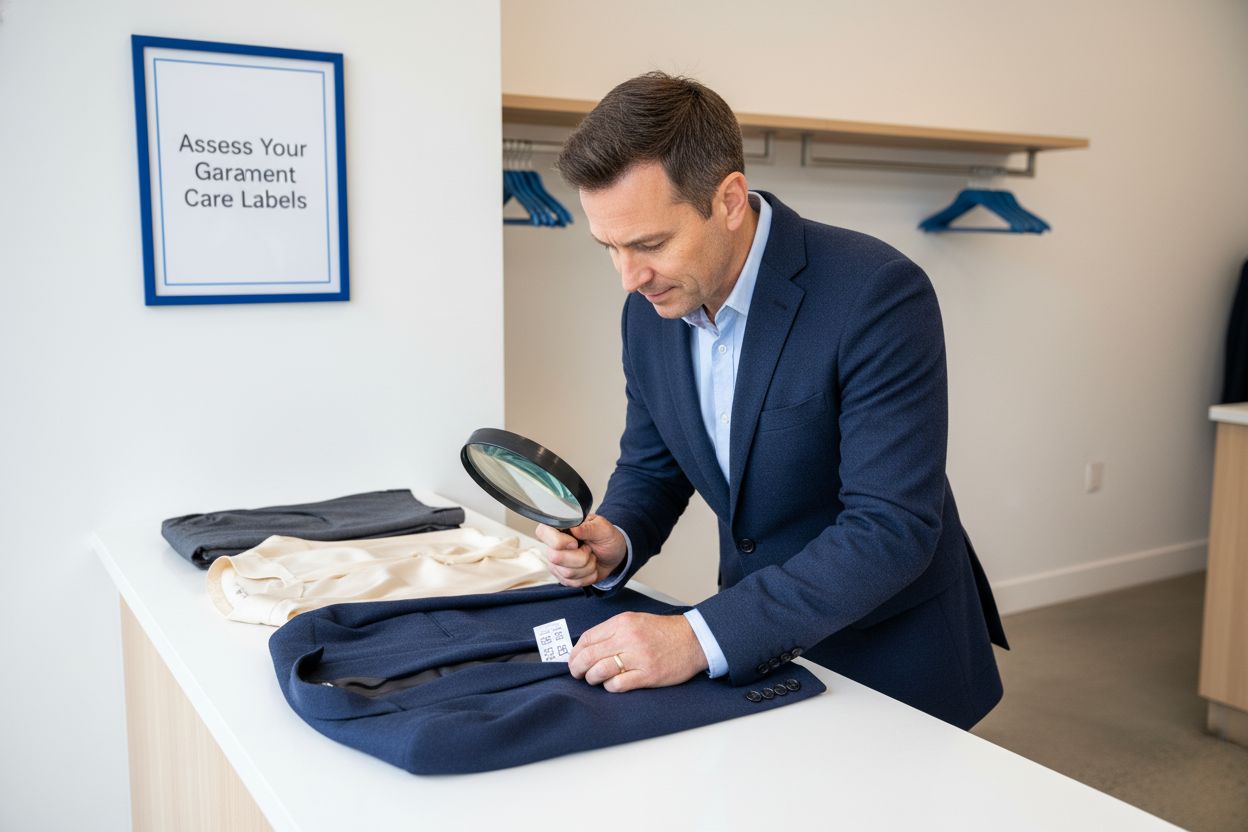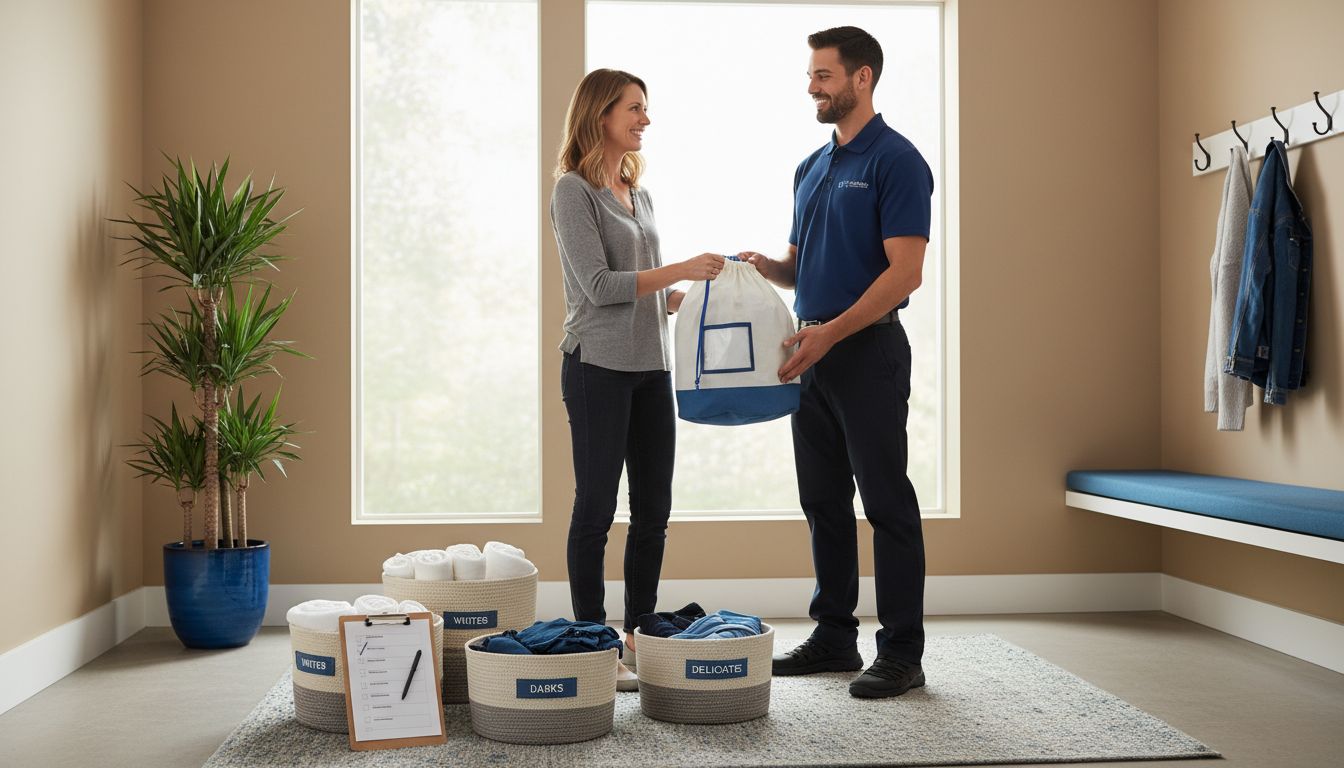What Happens If Your Laundry Service Loses Your Clothes?

The $2,000 Question Nobody Wants to Ask
Sarah from Ballston handed over three bags of laundry on a Tuesday morning—business suits, her daughter's soccer uniforms, and the dress she'd worn at her wedding rehearsal dinner. By Thursday, only two bags came back.
The missing bag? Gone.
The compensation? A $50 credit toward future service.
The frustration? Immeasurable.
If you've ever hesitated before handing your clothes to a laundry service, wondering "what if they lose something important?"—you're asking the right question. Because here's the uncomfortable truth: lost items happen in this industry. And how a company responds tells you everything about whether they deserve your trust.
The Industry's Uncomfortable Reality
Let's be honest about what customers face when laundry services lose their belongings.
Across the laundry service industry, lost items represent the single most devastating customer experience. When we analyzed thousands of customer reviews of major laundry services, a clear pattern emerged: customers regularly lose $500-$3,000 worth of clothing but receive compensation ranging from $150-$362 in store credits—rarely matching actual replacement value.
One customer lost an entire bag containing five brand-new suits and eight dress shirts worth over $3,000. The company's response? Weeks of vague replies and a suggestion that maybe the customer never sent the items at all, despite their own pickup records.
Another customer's $1,000 order vanished for three weeks. After persistent follow-up, the response was: "You have every right to be upset. There was a major mixup at our facility." The compensation offered? $200 in credits.
These aren't isolated incidents. They're patterns that reveal how some companies handle accountability when trust breaks.
Why Do Laundry Services Lose Clothes?
Understanding how items get lost helps you evaluate whether a service has systems to prevent it.
Mixed Orders During Processing
When multiple customers' laundry gets processed in shared facilities, sorting errors happen. Some services use gig-economy contractors who pick up from dozens of households, creating opportunities for bags to be mislabeled or mixed. One customer received a bag of someone else's baby clothes with their own name on the tag.
Lack of Photo Documentation
Without visual proof of what was received, disputes become your word against theirs. Several customers reported being told items "weren't in the bag" when they knew they'd included them.
Facility Transfer Issues
Tech-based platforms often don't process laundry themselves—they send it to third-party facilities. Items can disappear during these handoffs between drivers, facilities, and return delivery. One customer discovered their clothes had been sent to the wrong processing center across the city.
Inadequate Tracking Systems
When services don't scan individual items or use barcode tracking, there's no digital trail. If something goes missing, there's no way to determine when or where it disappeared.
The good news? Not every laundry service operates this way. Services with robust tracking, in-house processing, and photo documentation at every step virtually eliminate these problems.
Understanding the role of laundry services helps you evaluate which operational model protects your belongings best.
The Compensation Gap: What You'll Actually Get
This is where many customers feel most frustrated. Even when companies acknowledge losing items, compensation policies often favor the business over the customer.
Credits-Only Policies
Most major services only offer store credits—forcing customers who've lost trust to keep using them or forfeit any reimbursement. If you've just had $1,000 in clothes disappear, the last thing you want is to give that same company more business.
Artificially Low Coverage Limits
Some companies cap compensation at $200-$1,000 regardless of actual loss value. Others use formulas like "$1 per pound" that dramatically undervalue quality wardrobes. A $400 cashmere sweater and a $10 t-shirt both weigh about the same.
Burden of Proof Falls on You
Several companies require customers to provide purchase receipts for items they may have owned for years. One customer was asked to prove the value of a wedding jacket—because who keeps receipts for special occasion clothing?
Lengthy Claims Processes
Some customers report waiting weeks or months for resolution, filling out extensive documentation, only to be offered inadequate compensation. The process itself becomes exhausting enough that some people give up.
"At Our Sole Discretion" Clauses
Fine print often states that compensation is determined entirely by the company, with no objective standards. This gives them complete control over whether—and how much—to reimburse you.
The contrast is stark when you find a service that offers cash refunds, replacement value coverage, and same-day issue resolution. These companies understand that when they make a mistake, the right response is to make you whole, not make you jump through hoops.
Learn about laundry pricing factors to understand why some services can afford better compensation policies.
How Columbia Pike Laundry Handles Lost Items Differently
We built our entire operation around preventing lost items—because we know your clothes matter to you.
Photo Documentation at Every Step
Before we touch your laundry, we photograph it. Before delivery, we photograph it again. You get visual proof of what we received and what we're returning. If there's ever a question, we have timestamped evidence.
Barcode Scanning and Timestamp Tracking
Every order gets a unique barcode that's scanned when items enter our machines. We can track exactly when each piece was processed, which gives us camera footage to review if something seems missing. This system has helped us locate items that customers thought were lost—they were simply in a different batch than expected.
In-House Processing, Zero Third Parties
Your clothes never leave our facility or get handed off to contractors. Daniel processes orders himself alongside our W-2 staff. When you hand your laundry to us, you know exactly who's handling it and where it's going.
Replacement Value Policy
If we genuinely lose something—which is incredibly rare with our tracking systems—we reimburse you for the replacement value, not some arbitrary formula. Cash refund, not forced store credits. Because if we've lost your trust, making you keep using our service adds insult to injury.
Same-Day Human Response
No chatbots. No email-only support. Call our number and reach a real person who can pull up your account, review our documentation, and resolve issues immediately. When customers mention "I think something's missing," we're already pulling footage and tracking data while you're on the phone.
This isn't just good customer service—it's the bare minimum you deserve when trusting someone with your belongings.
See how our pickup and delivery process works to understand the systems protecting your clothes at every step.
Questions You Must Ask Before Choosing a Laundry Service
Protect yourself by knowing exactly what to ask before handing over your first bag.
1. "Do you photograph my laundry at pickup?"
If they don't, there's no proof of what was received. Your word against theirs if something goes missing.
2. "Is my laundry processed at your facility or sent elsewhere?"
Third-party processing creates handoff points where items disappear. In-house processing means accountability stays with one team.
3. "What's your exact compensation policy for lost items?"
Get specific numbers. "We'll make it right" means nothing if their idea of "right" is a $20 credit for your $300 jacket.
4. "Do you offer cash refunds or only store credits?"
Credits-only policies trap you into continued service even after they've lost your trust.
5. "Can I speak to a human immediately if there's an issue?"
If you can only reach chatbots or email support, expect delays when problems occur.
6. "Do you use barcode tracking or photo documentation?"
These systems dramatically reduce lost items and speed up recovery when something's misplaced.
7. "How quickly do you resolve lost item claims?"
Days? Weeks? Months? The timeline tells you how seriously they take accountability.
8. "Are my clothes washed separately or mixed with other customers?"
Shared loads increase the chance of items ending up in someone else's bag.
9. "What's your average resolution for lost item claims?"
Press for actual numbers. If they won't share data, that's a red flag.
10. "Can I see your customer reviews about lost items specifically?"
Any service confident in their process will show you how they've handled past issues.
These aren't aggressive questions—they're smart ones. A service with nothing to hide will answer them confidently. Evasive responses tell you everything you need to know.
Red Flags vs. Green Flags in Laundry Services
Knowing what to look for helps you avoid services that prioritize convenience over accountability.
🚩 Red Flags:
- No phone number to reach human support
- "Credits only" refund policies
- Gig-economy model with rotating contractors
- No photo documentation or tracking systems
- Vague answers about compensation policies
- Multiple customer reviews mentioning lost items
- Processing done at undisclosed third-party facilities
- "At our sole discretion" compensation clauses
- Takes weeks to respond to lost item claims
- Requires receipts you don't have for reimbursement
✅ Green Flags:
- In-house processing with W-2 employees
- Photo documentation at multiple points
- Barcode or RFID tracking systems
- Clear, written compensation policies
- Cash refunds available, not just credits
- Same-day human customer service
- Security cameras throughout facility
- Transparent about where clothes go
- Fast issue resolution (hours or days, not weeks)
- Zero or minimal lost item complaints in reviews
Your clothes represent significant financial investment. Don't gamble with services showing red flags just because pickup is convenient.
What "Lost Items" Really Cost You
The financial loss is obvious. But there are hidden costs that make lost laundry even more devastating.
Irreplaceable Sentimental Items
Wedding attire. A parent's vintage jacket. Your child's first sports uniform. These have value no compensation policy can match. Once they're gone, they're gone forever.
Time Spent on Resolution
Hours filling out claim forms. Days waiting for responses. Weeks of frustration. That time has value—it's time away from your family, your work, and your peace of mind.
The Mental Load
After losing items once, you'll photograph everything, check every bag obsessively, and feel anxious with each pickup. That mental burden adds stress to a service meant to relieve it.
Wardrobe Replacement Costs
Lost professional attire disrupts your work wardrobe. Lost kids' clothes means emergency shopping trips. Lost seasonal items means re-buying things you already owned.
Erosion of Trust
Once a service loses your belongings, you'll never fully trust them again. Every future pickup carries doubt. That's not how you should feel about a service you pay for convenience and peace of mind.
This is why prevention matters more than compensation promises. The best policy is the one you never need to use.
Discover how wash and fold services work to understand what systems protect your investment.
Frequently Asked Questions
Q: Is it normal for laundry services to lose items?
Lost items occur across the industry, but frequency varies dramatically by provider. Services with robust tracking and in-house processing rarely lose items. Those using gig-economy models or third-party facilities have significantly higher loss rates. The difference isn't luck—it's systems and accountability.
Q: Should I expect cash refunds or only credits?
You deserve the choice. Credits-only policies protect the business, not you. Quality services offer cash refunds because they understand that after losing your trust, forcing you to keep using them compounds the problem. Always ask about refund options before your first order.
Q: How long should it take to resolve a lost item claim?
With proper documentation systems, resolution should happen within 24-48 hours. Services that take weeks are either lacking tracking systems or avoiding accountability. If you can't get answers in days, that's a red flag about their operational standards.
Q: What should I do if a service loses my clothes?
Document everything immediately. Take photos of what you gave them (ideally before pickup). Request their photo documentation. Submit a formal written claim with specific item descriptions and values. If they're unresponsive, consider disputing the charge with your credit card company and filing a complaint with the Better Business Bureau.
Q: Should I pay more for a service with better tracking?
The cost difference between basic and premium services is often $0.50-$1 per pound. Compare that to the risk of losing a $300 jacket or $500 suit. Better tracking systems aren't a luxury—they're essential protection for your investment. The question isn't whether you can afford them, but whether you can afford not to have them.
Q: Are there items I shouldn't send to any laundry service?
Truly irreplaceable items with deep sentimental value—like wedding attire or a deceased relative's clothing—warrant extra caution with any service. For everything else, choose a provider with documentation systems that give you peace of mind rather than avoiding convenient services entirely.
Q: How can I tell if a service has good tracking before trying them?
Ask to see their process during a facility tour. Request examples of their photo documentation. Read reviews specifically mentioning lost items. Call their support line to see if you reach a human quickly. These signals tell you more than marketing promises.
Q: What if I receive someone else's laundry?
Contact the service immediately. This indicates serious sorting problems that put your items at risk too. Document what you received and insist on knowing where your actual order is. Consider switching services—if they mixed up delivery, they're likely mixing up processing.
Q: Do insurance or protection plans really help?
Most "protection plans" have limits far below actual replacement values and still only offer credits. Read the fine print carefully. The best protection isn't buying insurance—it's choosing a service that doesn't lose items in the first place.
Q: Should I photograph my laundry before every pickup?
With services lacking their own documentation? Absolutely. It takes two minutes and provides critical proof if something goes missing. With services that photograph everything themselves? You can skip this step—they're already protecting you.
The Bottom Line: Your Clothes Deserve Better
Laundry services that lose items and offer inadequate compensation aren't just frustrating—they're fundamentally disrespecting your trust and your investment.
You work hard for your wardrobe. Your professional attire represents career advancement. Your family's clothing represents daily life. Your special occasion pieces represent important memories. None of this should disappear into a black hole of "processing errors" and store credit offers.
The industry standard doesn't have to be your standard.
Columbia Pike Laundry was built by Daniel Logan, who understands exactly what you're risking when you hand over your clothes. As a dad managing a busy household, he knew that laundry services needed to be more than convenient—they needed to be trustworthy. That's why he created systems that protect your belongings as carefully as you would yourself.
In-house processing. Photo documentation. Barcode tracking. Camera systems. W-2 employees who treat your clothes like their own. Cash refunds if we somehow fail you. Human support available immediately.
These aren't upgrades or premium features—they're the baseline of how laundry service should work.
Your clothes are in bags right now, waiting for pickup. The service you choose determines whether they come back safely or become another lost item statistic. Choose the service that's earned your trust through systems, not promises.
Ready to experience laundry service built on accountability, not excuses? See our complete service area coverage across Northern Virginia to confirm we serve your neighborhood. Check out how our laundry pickup and delivery works to understand the protection at every step. Schedule your first pickup at Columbia Pike Laundry and discover what it feels like to trust your laundry service completely.
Popular Blog Articles

Meet the Author
Daniel Logan didn’t start CPL because he loved laundry. He started it because his family was drowning in time debt, and laundry was one of the biggest weights.
Mornings were chaos with two kids under 5. Evenings felt like catch-up. And weekends? Gone to sorting socks and folding piles.
He knew his story wasn’t unique. So he built a business that gave families like his just a little bit of breathing room one load at a time.
With no laundry experience but deep tech skills, Daniel rolled up his sleeves, doing every job himself while building systems that turned it into a modern laundry service that saves customers time, simplifies their lives, and delivers reliability they can count on.
That’s where CPL began. Not from a playbook, but from pain. From one dad trying to buy back time: for himself, and for every household like his.







